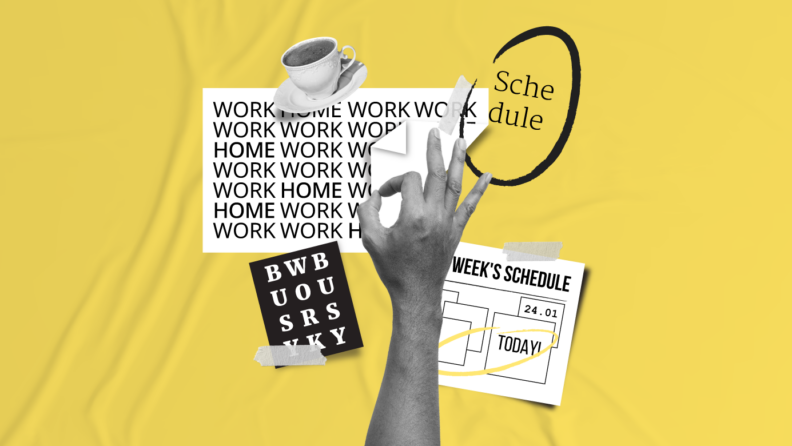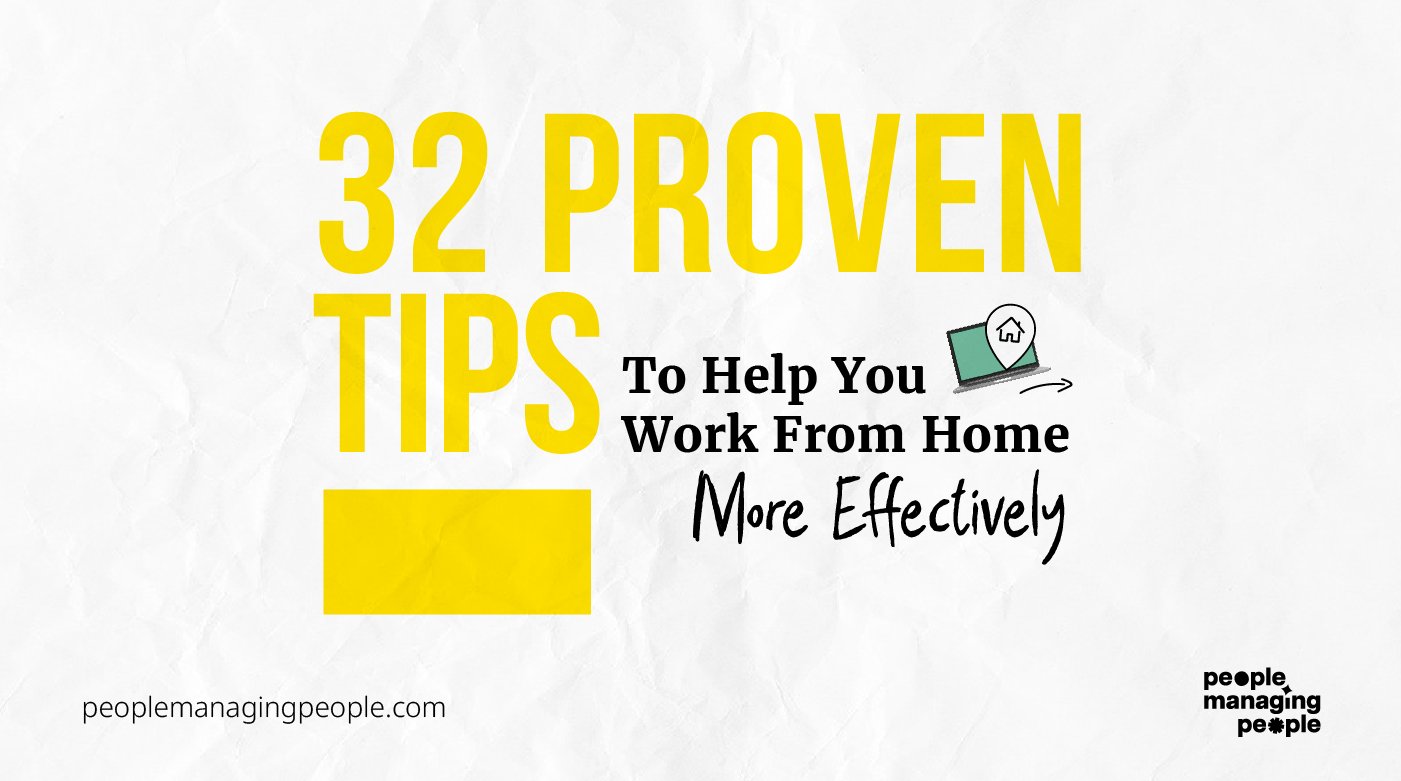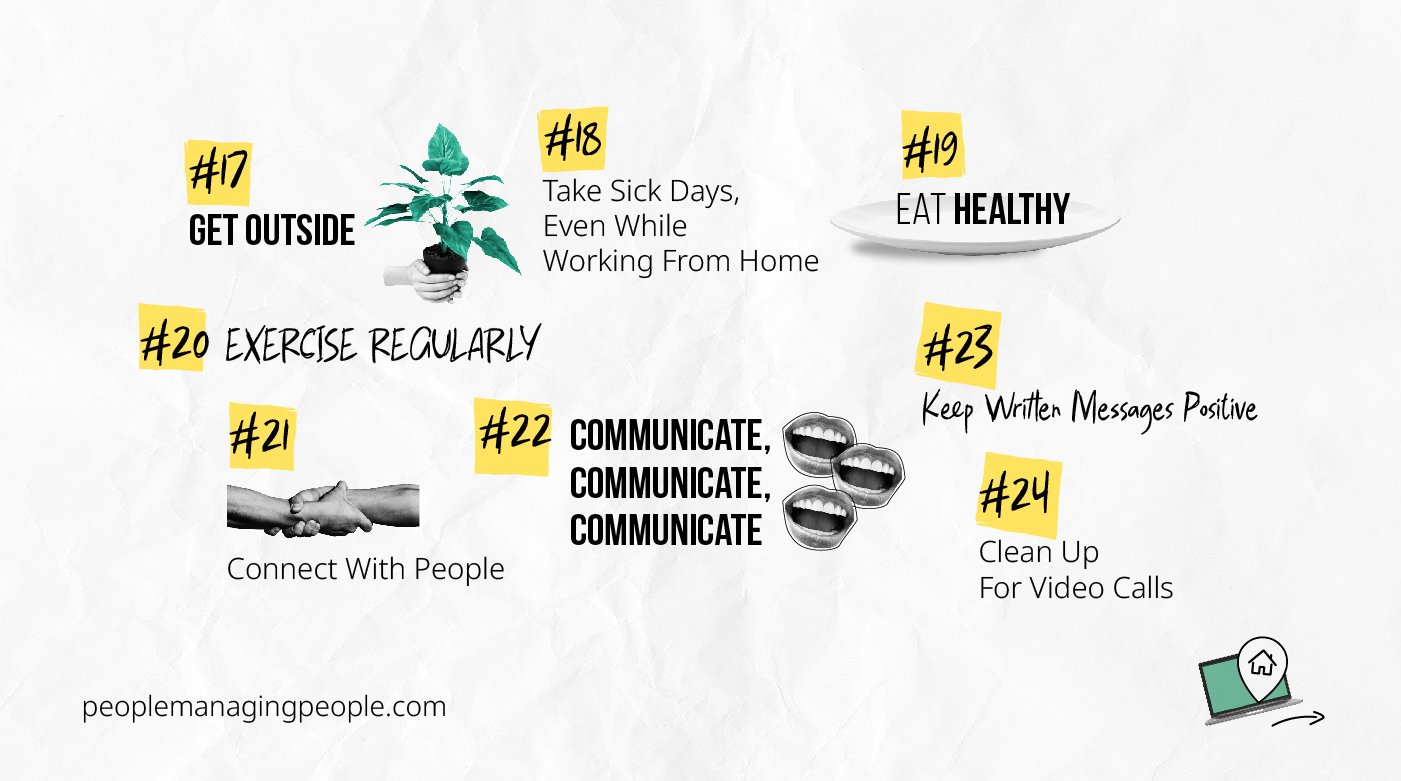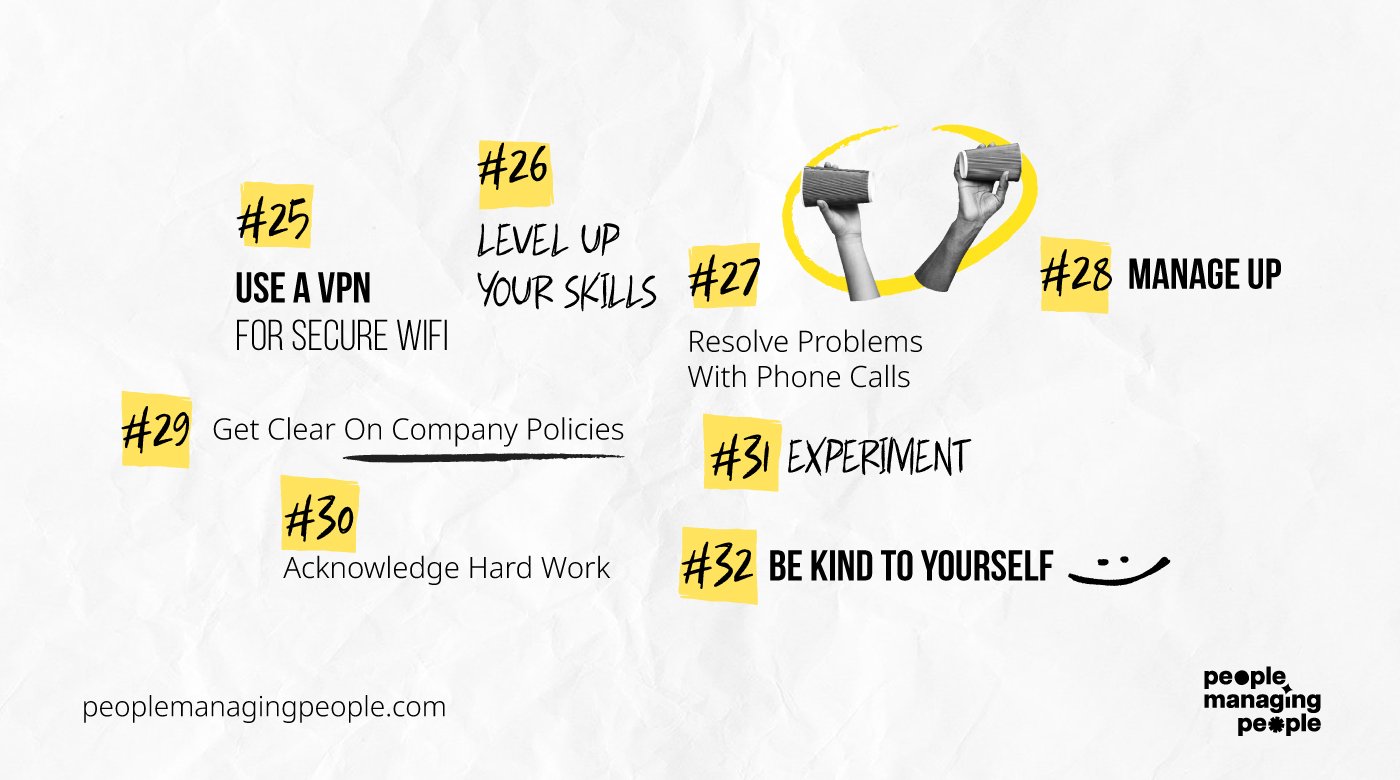Working from home may be on the decline as return to office mandates force employees back into their cubicles at least part time, but the number of people who work from home is still far greater than pre-pandemic levels.
Yet while remote work comes with benefits like flexibility and better work life balance, it means a new approach to work.
Read on for 32 tips on staying focused and productive while working remotely.
#1 - Set A Schedule And Stick To It
For remote workers, the boundaries between work and personal life tend to get blurred. If you're not careful, you might stretch yourself thin past work hours and not consciously take enough time to rest or socialize.
Creating a daily schedule puts firm boundaries around your workday. You know when you're going to start work, when you'll take breaks, and when you'll stop for the day. This allows you to get into a daily rhythm and even set expectations with your remote team.
You'll spend less time trying to decide what you're going to do, which reduces the amount of decision fatigue you experience and increases productivity.
Make your schedule clear to your coworkers so that they know when you're in work mode:
- Google Calendar allows you to create shared calendars so that people know what you're doing on each day of the week.
- Calendly makes it simple to agree upon meeting times without sending dozens of emails back and forth.
#2 - Quit At Quitting Time
In an office, you leave the building and go home at the end of the day, which puts a hard stop on your work hours. Switching locations also gives your brain a physical cue to focus on a new task, but this isn't the case with the home office. With work and personal life at home, you may find yourself checking your inbox or internal chat at all hours.
This is a sure recipe for burnout.
We already know that a majority (70%) of employees say their company needs to do more to prevent burnout. But you can do your part to prevent it, too.
At the end of the day, stop working completely. Create an offboarding of your day: close out browser tabs, shut your laptop, and tidy up your workspace so that it's clean for the next morning.
If you have a separate home office area or room, leave the space. Then give all your attention to the remainder of your evening so your brain knows it should focus on rest.
#3 - Get Dressed when Working from Home
One of the great advantages to working from home is that you don't need to suit up. However, as tempting as it is to work in your pajamas, your productivity is scientifically proven to increase if you "dress for success".
It's called enclothed cognition, and in the same way a suit might make us feel powerful, scrubs or a doctor's coat makes the wearer feel more responsible and empathetic.
Getting dressed also mentally prepares you to tackle the day and be more engaged, and it creates a boundary between lounging in your PJs and work.
#4 - Communicate Expectations To Those Around You
Those at home with you (roommates, kids, etc.) need to know what you expect from them. Communicate your work hours and designated home office space.
Let them know your routine, especially if you're a hybrid worker who goes into the office a few times a week. Help the household adapt to your flexible schedule by establishing your boundaries and needs so you're time isn't infringed on to do errands, play with your kids, etc.
Author Glenn Fleishman recommends:
- Having a conversation with family or roommates so that they know how you'll be working
- Sticking to a regular schedule so that everyone knows when you're working
- Having some sort of sign or signal that you're working (closed door, headphones, etc.)
#5 - Observe Routines
Most of us have routines and rituals before we start working. We drink coffee, exercise, or read the headlines. Going through these routines signals to our brains and bodies that it's time to start working. They become habits and create mental "grooves" of sorts. These mental grooves make it easier to actually get started.
Additionally, routines have been demonstrated to improve sleep cycles, which consequently helps reduce stress and improve mental health.
In a remote job, it's up to you to create that pre-work ritual that helps you get in the right headspace to be productive. Maybe that ritual involves drinking a cup of tea and going for a jog. Maybe it involves meditating using an app like Headspace or Calm.
The more you utilize routines, the easier it will be to get your workday started.
#6 - Take Regular Breaks during Work Hours
As a remote employee, it's easy to forget to take breaks. You just keep working, maybe even going so far as to eat lunch while in front of your laptop. This is a sure recipe for burnout and exhaustion.
Throughout the day, your body goes through multiple cycles of high and low energy called " ultradian rhythms ". These cycles occur every 90 - 120 minutes and play a large part in how productive you are. At the peak of a cycle, your energy is highest and at the trough its lowest.
The implication is that you'll be most productive if you work with your body instead of against it. Focus on getting things done when energy levels are high and then give yourself space to recover.
Consciously include regular breaks in your schedule and be sure to take them. Resist the temptation to just keep going or to answer that quick coworker question. Add the away messages on Microsoft Teams or Slack to signal you're at lunch for an hour, and give yourself the permission to close your laptop for a break in the day.
Related Read: 9 Tweaks To Make Shift Working Even Better For Your Employees
#7 - Create Your Own Office Space
Increased productivity is the result of habits, and numerous studies have shown that habits are the result of associations. We take action, observe the outcome, and then repeat that action if the outcome is good. The more we do this, the stronger the habit becomes.
When you enter your office or cubicle at work, you know that it's time to be productive. It's not time to stream movies or check social media. There is a direct association in your brain between your workspace and productivity.
Create a dedicated office space—either a room or even a corner—in your home specific for work. You can also ask your employer if they might cover a co-working space membership for their remote workforce.
Having one spot where you always work creates an association in your brain between that spot and getting things done.
#8 - Make Your Workspace Comfortable
You're going to be spending a lot of time in your workspace, so do your best to make it comfortable. If you hate being in your workspace, it will be hard to be productive.
Get a chair you like that supports good posture. Make sure the space is well-lit, preferably with natural light. Light a candle to keep things smelling nice and maybe put up a few photos. You can even create an area where you can take video calls for Zoom or Google Hangouts so you know your background is always clean and tidy.
Your employer might also include a remote work stipend to help fund any office supplies you need.
#9 - Get The Right Tools
If you're going to be productive from home, you need to have the right tools for the job.
You may need to buy a laptop or tablet or some other tool. You also may need to invest in a faster internet connection if you're going to be transferring a lot of files or remotely controlling a computer at work. You may need electronic signature software to simplify approval processes and keep your home office workflow moving efficiently.
You'll also need the right communication tools to chat with your coworkers and collaborate on projects. Applications like Slack , Google Docs , Dropbox , and Loom can help you stay in sync with people.
Related read: 10 Best Remote Working Software for Distributed Teams
#10 - Keep A Task List
Office workers are constantly in contact with the boss, who helps them know what needs to be done and when. With remote working, that physical proximity is gone. You have an increased responsibility to identify important tasks and get them done.
Maintaining a task list can help you stay on top of deadlines. Each day, before you start working, prioritize your task list and communicate up any questions you might have for deadlines.
In his book The ONE Thing: The Surprisingly Simple Truth Behind Extraordinary Results, Gary Keller writes:
"Getting extraordinary results is all about creating a domino effect in your life. Toppling dominoes is pretty straightforward. You line them up and tip over the first one...Highly successful people know this. So every day they line up their priorities anew, find the lead domino, and whack away at it until it falls."
Using a task list helps you create the domino effect. It ensures that you get the most important things done every day, which leads to extraordinary results.
#11 - Tackle the Most Important Tasks when You're at Peak Productivity
There are points during the day when you work more effectively. When you're able to think most clearly and get things done most efficiently.
Be cognizant when you're in peak productivity mode so you can work on those important projects. If you're freshest first thing in the morning, don't waste that time on relatively trivial tasks like email. Focus your energies on the task that will have the biggest impact.
This is how author Stephen King produces best-selling novels year after year. As Mason Curry notes in the book Daily Rituals: How Artists Work, King writes every day of the year starting at around 8:00 am, and he doesn't stop until he reaches 2,000 words. Only then does he do less important things.
#12 - Don't Multitask
For remote employees, it's easy to get sucked into the trap of multitasking. One minute you're working, the next you're cleaning up the kitchen or running out for quick errands.
This kills productivity. Time and again, research has shown that multitasking makes you far less efficient. The effort involved in switching back and forth between tasks requires more mental energy, increases the chances of error, and increases the amount of time it takes to complete tasks.
As much as possible, try to stay focused on a single task. Work in discrete blocks of time and focus on only one thing during each block (known as " time blocking "). Don't let your attention be spread thin.
#13 - Use The Pomodoro Method For Productivity
The Pomodoro Method is a well-established technique that helps you work in focused bursts and then giving your brain a break. It works like this:
- Identify your most important task.
- Set a timer for 25 minutes.
- Work on the task for 25 minutes (one Pomodoro session).
- Take a 5-minute break.
- After four Pomodoro sessions, take a 15-20 minute break.
Using this technique keeps you on task, helping you give focused energy to the things that are most important. It also keeps you from working too long without taking a break.
#14 - Use White Noise to Block Out Distractions
There are going to be distractions when you have a working-from-home job. If you have kids or roommates, there may be a fair amount of noise. If you don't have an office where you can close the door, that noise will probably make it harder for you to get things done.
One relatively simple solution is to get noise-canceling headphones and then listen to background music or ambient noise that won't distract you. Some listening options to consider:
#15 - Block Time-Wasting Websites
Social media is one of the biggest time wasters. One minute you're working away, the next, you're sucked into the black hole of doom scrolling.
If you have trouble resisting the allure of Tiktok or other favorite sites, consider using an application that will physically prevent you from accessing those URLs: Freedom and Rescue Time both allow you to block specific websites for set periods of time so you can enjoy distraction-free productivity.
#16 - Respond To Messages In Batches
In an effort to prove that you're working diligently and being productive, you may be tempted to immediately answer every message or quick question a coworker sends your way. Your inbox dings, you stop what you're doing, and you fire back a response.
It's understandable, but it can distract you from your work at hand or make you lose focus and momentum.
Try responding to messages in batches. Emails, Slack messages, or pings on MS Teams, you can block notifications for focus time, then return to any questions at specific times of day or in between work springs.
#17 - Get Outside
With telework you might find yourself at home too long. Without a daily commute or office happy hours, you might find yourself spending all of your time inside, which is bad for morale and for your health.
Numerous studies have demonstrated the benefits of being outside. It contributes to:
- Reduced stress
- Improved immunity
- Increased focus
- Better mental health
- Improved short-term memory.
Additionally, being outdoors increases the amount of vitamin D in your body, which is essential (approximately 42% of Americans are vitamin D deficient).
Try to get outside your house every day. Go for a walk. Read in a coffee shop. Grab drinks with friends. It may seem counterintuitive, but getting away from where you work will actually make you more productive.
#18 - Take Sick Days, Even While Working From Home
In the United States, in particular, employees seem to have a particular aversion to taking sick days. In a culture of constant productivity, taking a sick day can seem like weakness, but nothing could be further from the truth.
If you don't take sick days, you may actually prolong your illness since your body can't heal. This was demonstrated during the 2016 presidential election when Hilary Clinton almost physically collapsed due to pneumonia. Unable to rest, a cough morphed into something much more serious.
The moral of the story? Take care of yourself.
If you're sick, take time off to rest and recuperate. Don't try to power through. Flexible work doesn't mean you should work from your bed. Take sick time off and let your body fully recover. Your work will be better when your health is better.
#19 - Eat Healthy
When you're working from home, your pantry is never more than a few steps away. There's a huge temptation to mindlessly snack, especially on sugary treats, which can quickly turn into additional pounds and impair your cognitive functions and energy level.
There are a number of specific strategies you can employ to help you eat healthy at home:
- Set specific times when you will snack and stick to those times rigidly
- Stock up on healthy snacks that satisfy cravings but don't add to the waistline
- Prepare meals and snacks the night before so that you're not tempted to just grab whatever is in front of you
- Keep a water bottle close by to ensure that you're hydrated
- Use the " Healthy Plate Method " to help with portion control
- Use an app like MyFitnessPal to help you track the calories you consume
#20 - Exercise Regularly
Few things improve productivity like exercise. It clears your head, improves your energy, and lifts your mood. A recent study by Briston University evaluated the immediate impact of exercise on productivity, with employees comparing days they exercised versus days they didn't.
On the days they worked out, the employees experienced higher levels of concentration, managed their time more effectively, and felt significantly more motivation.
Add a walk or jog into your routine. If the weather is bad, download a workout app like Nike Training Club or try a yoga class on Youtube. Consistently exercising will make the experience of working from home significantly better.
#21 - Connect With People
Loneliness is an occupational hazard when it comes to working from home. You can't casually chat with coworkers about sports or the latest movie you saw. While virtual meetings enable remote teams to connect, they might not be conducive to socializing.
Prolonged loneliness and isolation can lead to a variety of health problems, including:
- High blood pressure
- Depression
- Cognitive impairment
- Anxiety
- Heart disease
- Obesity
- And more
For the sake of both your physical and mental health, make an effort to connect with people a few times per week. Go to lunch with a friend or grab coffee with a neighbor.
You can even connect with coworker friends for quick catchups using any of the video conferencing tools like:
Socializing with teammates is so important for building up work culture and creating connection.
#22 - Communicate, Communicate, Communicate
Communication becomes even more important when you're not working in an office. You're not getting regular face time with your supervisor or coworkers, and things can easily get lost in strings of emails and messages.
Tell your boss and coworkers your schedule. Let them know when you complete a task. Make it clear when you're taking vacation days. Communicate the same message via chat, email, video conference, etc. You can also add your work hours on your calendar.
It's better to over-communicate than under-communicate. Under-communication leads to misunderstandings, missed deadlines, and a lot of frustration.
#23 - Keep Written Messages Positive
Tone and body language are lost when communicating digitally with your remote team. People can't see your face or hear your voice. It's really easy for people to interpret your words in a negative way even if you didn't intend any negative connotations.
According to Inc., writer Jacquelyn Smith:
"...tone is easy to misconstrue without the context you'd get from vocal cues and facial expressions. Accordingly, it's easy to come off as more abrupt than you might have intended—you meant 'straightforward,' they read 'angry and curt.' [...] For best results, avoid using unequivocally negative words ('failure,' 'wrong,' or 'neglected'), and always say 'please' and 'thank you.'"
When communicating over email or chat, keep things light and positive. Maybe throw in a joke or your favorite emoji or GIF where appropriate. Little things like this go a long way in helping you maintain good relationships with your coworkers.
#24 - Clean Up For Video Calls
A big advantage of working from home is that you can wear comfortable clothes. However, you still want to look professional during video calls.
Like it or not, your appearance is directly tied to your success. Research suggests that the way a person looks plays a really significant role in career advancement. As much as possible, try to look good when interacting with other employees, even if it's just during a video call.
Don't wear a ratty t-shirt and have your hair going all over the place. Put on an appropriate shirt, comb your hair, shave, etc. Make it clear that you really do care about the work you're doing.
#25 - Use A VPN for Secure WiFi
As a remote worker, you can work wherever: a coffee shop, a library, or a co-working space. However, when you're using public wifi it's important to be secure, so use a VPN.
A VPN gives you a secure internet connection, ensuring that someone doesn't steal important company information. The last thing you want is to have a security breach, and a VPN helps prevent that.
Some effective VPN apps are:
#26 - Level Up Your Skills
Learning and development training is a staple for employee engagement at the office. However, as a remote worker, additional training or sighing up for additional courses will be up to you.
Your organization might have learning and development opportunities for their remote employees and some organizations also include free access to online courses through other providers, like SkillShare or Lynda Learning.
You can also find your own courses from a number of online platforms that provide in-depth training. Check out:
#27 - Resolve Problems With Phone Calls
If you sense a problem starting to arise, don't try to solve it via email or chat. Misunderstandings are common with these methods of communication and things can quickly get worse.
To navigate conflicts, hop on the phone or a video chat and have a conversation with anyone involved.
Kevin Hart, SVP and Managing Director at EMA Boston, says :
"Holding people accountable or having a fierce conversation is best done in person. It gives you better understanding of tonality and allows you to observe body language. Also, there's more room for two-way communication. We encourage face-to-face meetings to resolve conflicts. If that is not possible, a phone conversation is the next preferred way to determine how to move forward."
#28 - Manage Up
Remote working requires open communication and being a proactive teammate. Ensure you're on top of deadlines and expectations by managing up—communicating openly with your supervisor.
Ask them what they think is working and what isn't. Take notes on the feedback and assure your boss that you really do want to be as efficient as possible.
Also, let your supervisor know of any unique challenges you're facing that you don't encounter in the office. Are you encountering any bottlenecks? Are there any tools you need? This kind of open dialogue will keep things running smoothly and keep yourself motivated.
#29 - Get Clear On Company Policies
Your company probably has specific policies and guidelines related to working from home, and in some cases the crisis has been a catalyst, prompting companies to upheave and shift their policies in an entirely new direction. New policies could include everything from what hours you need to be available to what you're allowed to use your company laptop for.
Make sure you're crystal clear on these. Knowing exactly what your company expects from you can help you avoid misunderstandings. It also ensures that you and your supervisor are on the same page. If you have questions regarding certain policies, get clarity as soon as possible.
#30 - Acknowledge Hard Work
In the office, with our managers nearby and the influence of coworkers around us, we're more likely to stay focused and accountable for deliverables. However, with remote working, you need to possess that self-motivation, so ask yourself: "what would motivate you?"
For many, that can be something as simple as employee recognition for hard work.
Employee recognition strategies not only bolster culture but it also motivates workers, and, when you're working from home, you might not get that immediate positive feedback loop from your coworkers or manager.
When you perform a task, talk to your supervisor about it and share your hard work. Most of all, acknowledge when you see a teammate do something great too! That can help create a positive, motivating team culture.
You can also ask your supervisor or coworkers for feedback. Managers can track this through a performance management tool so they can view overall progress and growth, helping you see your own hard work. Employee recognition software can also help peers recognize each other regularly too.
#31 - Experiment
It may take you some time to figure out what works best for you when it comes to working from home. Don't expect everything to fall neatly into place right at the beginning. You'll need to find what works best for you and your style of working.
Feel free to experiment with your schedule, workspace, task list, management tools, routine, etc. The beauty of working from home is that you have the freedom to change these things. You can optimize your working day for maximum productivity.
#32 - Be Kind To Yourself
It takes time to get used to working at home. It's a new work environment that requires new skills. It will take time for you to find your groove. Some days will be less productive than other days, and that's okay.
Show yourself compassion. Give yourself time and space to get acclimated. Over time, things will get easier. Until then, be kind to yourself.
Ready to Stay Productive When Working from Home?
Whether you're a hybrid worker or fully remote, finding the best way to stay productive is a process but doable with the right mindset.
Find what routine works for you, create a dedicated workspace, and don't forget to communicate, communicate, and communicate with your team and manager.
Related read: Best Note Taking Apps for Boosting Productivity








